Effects of Different Microbes on Fermenting Feed for Sea Cucumber (Apostichopus japonicus)
JIANG Yan, WANG Yingeng,, MAI Kangsen ZHANG Zheng, LIAO Meijie, and RONG Xiaojun
1) Key Laboratory of Mariculture of Ministry Education of China, Ocean University of China, Qingdao 266003, P. R. China
2) Yellow Sea Fisheries Research Institute, Chinese Academy of Fishery Sciences, Qingdao 266071, P. R. China
Effects of Different Microbes on Fermenting Feed for Sea Cucumber (Apostichopus japonicus)
JIANG Yan1),2), WANG Yingeng2),*, MAI Kangsen1), ZHANG Zheng2), LIAO Meijie2), and RONG Xiaojun2)
1) Key Laboratory of Mariculture of Ministry Education of China, Ocean University of China, Qingdao 266003, P. R. China
2) Yellow Sea Fisheries Research Institute, Chinese Academy of Fishery Sciences, Qingdao 266071, P. R. China
? Ocean University of China, Science Press and Spring-Verlag Berlin Heidelberg 2015
The effects of different microbes on fermenting feed for sea cucumber (Apostichopus japonicus) were compared to select the optimal fermentation strain in this study. Saccharomgces cerevisae, Candida utilis, Bacillus subtilis and Geotrichum candidum were independently added into the experimental compound feed, while only saline was mixed with the control feed. The fermentation treatments were inoculated with 10% seed solution under the condition of 25℃ and 70% water content, which lasted for 5 days to elucidate the optimal microbe strain for fermenting effect. Physicochemical indexes and sensorial characteristics were measured per day during the fermentation. The indexes included dry matter recovery (DMR), crude protein (CP), the percentage of amino acid nitrogen to total nitrogen (AA-N/tN), the percentage of ammonia nitrogen to total nitrogen (NH3-N/tN), and the ratio of fermentation strains and vibrios to the total microbes, color, smell and viscosity. The results showed that DMR, CP and AA-N/tN of the S. cerevisae group reached the highest level on day 3, but the ratio of fermentation strain was second to C. utilis group. In addition, its NH3-N/tN and the ratio of vibrios were maintained at low levels, and the sensory evaluation score including smell, color and viscosity was the highest in S. cerevisae group on day 3. Therefore, S. cerevisae could be the optimal strain for the feed fermentation for sea cucumber. This research developed a new production method of fermentation feed for sea cucumber.
Apostichopus japonicus; fermentation feed; strain; physicochemical index; sensorial characteristic
1 Introduction
As it is good for human health, the sea cucumber (Apostichopus japonicus) is a commercially important echinoderm in Asia (Sun et al., 2004; Okorie et al., 2008). The trend of exploitation was increasing and the natural population of sea cucumber had been decimated in some areas (Hamel et al., 2001; Conand, 2004; Uthicke, 2004). To meet the consumption requirements, the stock enhancement and aquaculture programs for A. japonicas have been encouraged (Conand, 2004; Yuan et al., 2006).
A. japonicus is a single breeding with the highest productive value and remarkable economic benefit in mariculture in China. Its culture area is more than 150000 hectares, while the annual production was 140000 tons and the output value was more than 30 billion RMB (MOAC, 2012).
The holothurians which have deposit feeding habits usually ingest the sedimentary organic matter, including bacteria, protozoa, diatoms, and detritus of plants and ani-mals (Choe, 1963; Yingst, 1976; Moriarty, 1982; Zhang et al., 1995). In some studies, sea cucumber showed significant growth by feeding Ulva lactuca, Laminaria japonica, Sargassum thunbergii, Sargassum polycystum and sea mud (Battaglene et al., 1999; Zhu et al., 2007; Liu et al., 2010). Powdered macroalgae, S. thunbergii and S. polycystum, were traditionally considered to be the best choice. As A. japonicas culture industry grows, the quantity of the macroalgal demand for feed is also increasing. The resources of these two macroalgal species decreased dramatically and the price became very high since the expansion of sea cucumber farming and the mass use of these two macroalgae (Yuan, 2005). Furthermore, the traditional powdered feed can easily make the water turbid and the feed would gradually deteriorate leading to the outbreak of various diseases (Wang et al., 2005; Wang et al., 2006). Some researchers began to find substitutes or partial substitutes for S. thunbergii and S. polycystum (Yuan et al., 2005; Liu et al., 2010; Seo et al., 2011). However, some research has not been successful because of several limitations; therefore, a newstyle feed need be developed for sea cucumber. Fermentation feed has a considerable market potential.
The application of fermentation feed in animal hus-bandry is prevalent (Jensen and Mikkelsen, 1998; Kim et al., 2001; Brooks, 2003; Li et al., 2003; Kobashi et al., 2008; Guo et al., 2009), but relatively rare in aquaculture (Chen, 2005; Luo et al., 2004; Demecková et al., 2002; Zhang et al., 2011). Previously, some researchers used fermented algal powder or fermented formula feed in sea cucumbers farming and the utilization rate of feed has been effectively improved (Yuan et al., 2006; Jiang et al., 2012).
Saccharomgces cerevisae, Candida utilis, Bacillus subtilis and Geotrichum candidum could produce a variety of nutrients, such as protein, vitamin among others. S. cerevisae, C. utilis and B. subtilis are probiotics for sea cucumber. These four strains have been widely used in the fermentation researches (Wang et al., 2006; Liu et al., 2010; Yun et al., 2010; Luo et al., 2011; Yang et al., 2011) and the results were positive. In this research, these four strains were studied to select the optimal one for developing fermentation feed for sea cucumber.
2 Materials and Methods
2.1 Bacterial Strain and Cultivation
S. cerevisae (CICC 1251), C. utilis (CICC 31188), B. subtilis (CICC 10073) and G. candidum (CICC 1315) were bought from China Center of Industrial Culture Collection (Beijing, China). These four strains were selected through induced salt tolerance in their own solid medium, respectively.
S. cerevisae and C. utilis were cultured in YPD medium at 37℃, B. subtilis was cultured in PDA medium and G. candidum was cultured in TSB medium at 28℃. Two percent salt was added into YPD, PDA and TSB media. These strains were independently cultured in their own solid medium for 48 h, 48 h, 36 h and 36 h in digital biochemical incubators. Meanwhile, four kinds of microbial suspension with 108cfu mL-1were prepared with 2% saline and colonies of these four strains. They were inoculated to their own liquid medium with the proportion of 10%, respectively, and cultured to the logarithmic phase in vibration cultivating box with 120 r min-1. Then, these four fermentation liquors were concentrated into 108cfu mL-1and used as the seed solution for feed fermentation.
2.2 Preparing Fermentation Feed with Different Microbes
This experiment consisted of five groups, each was treated in triplicate. The first group was fermented with S. cerevisae; the second with C. utilis; the third with B. subtilis; the fourth with G. candidum, and the fifth as control without any exogenetic microbe.
During the fermentation experiments, 7 liters autoclaved sea water were added to 3 kg feed (Table 1) in the plastic container of 13 liters, inoculated 300 mL S. cerevisae seed solution, fermented at 25℃ for 5 days and stirred once per day. The fermentation containers were enclosed by two-layer medical gauze and absorbent cotton, which allowed the air to enter into the container, and the aerobic fermentation could be conducted. The fermentation conditions including water content (50%) and temperature (25℃) were on the basis of the preliminary experiments. The process of treating C. utilis, B. subtilis and G. candidum was the same as that of S. cerevisae. In the control group, only 300 mL saline (2%) was added into the container. The samples were collected after stirring every day at certain time.
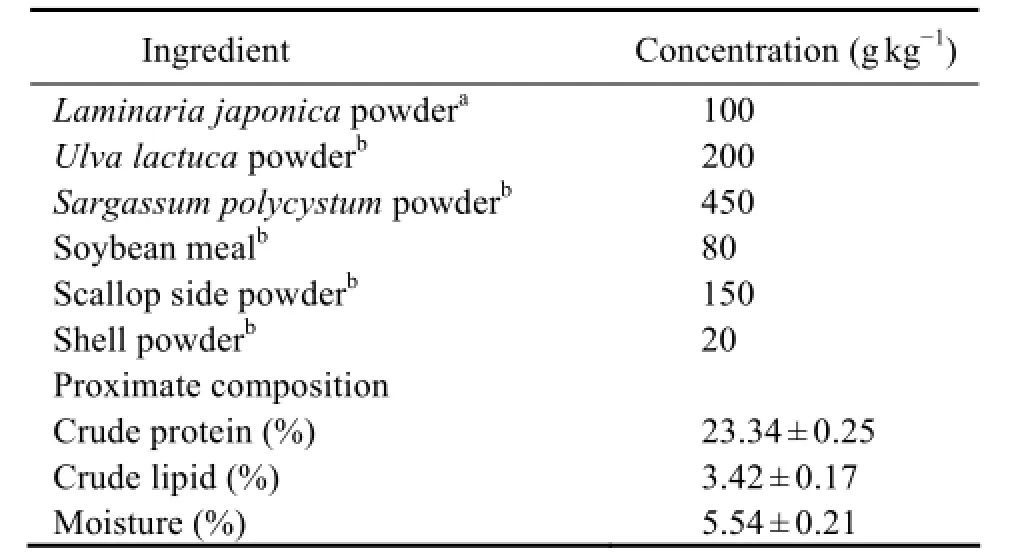
Table 1 Formulation of basal feed in fermentation on a dry matter basis
2.3 The Evaluation Index
Dry Matter Recovery (DMR): The DMR was calculated according to the weight of dry matter content before and after fermentation (Zhuang et al., 2006).
Determination of Crude Protein, Total Nitrogen and Amino Acid: The fermentative samples were dried at 65℃ and smashed. The crude protein (CP) and total nitrogen (tN) were analyzed by Kjeldahl method (UDK142 automatic distillation unit; VELP, Usmate, MB, Italy), and amino acid (AA) by amino acid automatic analyzer (HITACHI LP-2000, Japan).
Ammonia Nitrogen (NH3-N): Estimation of NH3-N was conducted following the hypobromite oxidation method (ICS 07.060 A45).
Microbes in Fermentation: The amount of microbes, vibrios and fermentation strains of each fermentation group were tested on TSB, TCBS and the fermentation strain’s culture medium.
Sensorial Evaluation: The sensorial characteristics of fermentation feed include color, smell and viscosity. Feed samples were assessed by a panel of ten researchers using a score range of 1.00 (worst) to 5.00 (best) (?ner et al., 1993; Tamang and Nikkuni, 1996; Omafuvbe et al., 2002). The data obtained were subjected to statistical analysis. The characteristics of good fermentation feed include an acid aroma, grayish brown, soft in texture and easy to mash between the fingers (Ikenebomeh, 1989).
2.4 Statistical Analysis
The data from each treatment were analyzed by SPSS 16.0 for windows and used analysis of variance(ANOVA) followed by Tukey’s multiple range tests. Statistical significance was chosen at P < 0.05 and the results were presented as means ± S.D.
3 Results
3.1 The Effects of Fermentation Strains and Time
3.1.1 DMR
The effects of fermentation strains and time on DMR were significantly different (P < 0.05). The changing trend of DMR was not consistent in fermentation process (Fig.1a). DMR achieved the highest level (98.19%) at the third day in the group of S. cerevisia. This value was not significantly different from the C. utilis group on day 3 (P > 0.05), but significantly higher than those at other time in the fermentation feed of S. cerevisiae (P < 0.05). The DMR of B. subtilis group and G. candidum group achieved the highest level on day 4 and day 5 (Fig.1a).
3.1.2 CP
There were significant differences on CP by fermentation strains and fermentation time (P < 0.05), respectively. The CP of the five fermentation groups overall manifested the same change trend (Fig.1b). The highest was 25.24% in S. cerevisiae group at the third day. No significant difference of CP was observed between B. subtilis group (24.74%) and S. cerevisiae group at the same time (P > 0.05). The CP of fermentation feed on day 3 was not significantly different from day 4 (24.94%) in S. cerevisiae group (P > 0.05). The significant differences on CP were observed by the interactions of fermentation strains and time (P < 0.05).
3.1.3 AA-N/tN
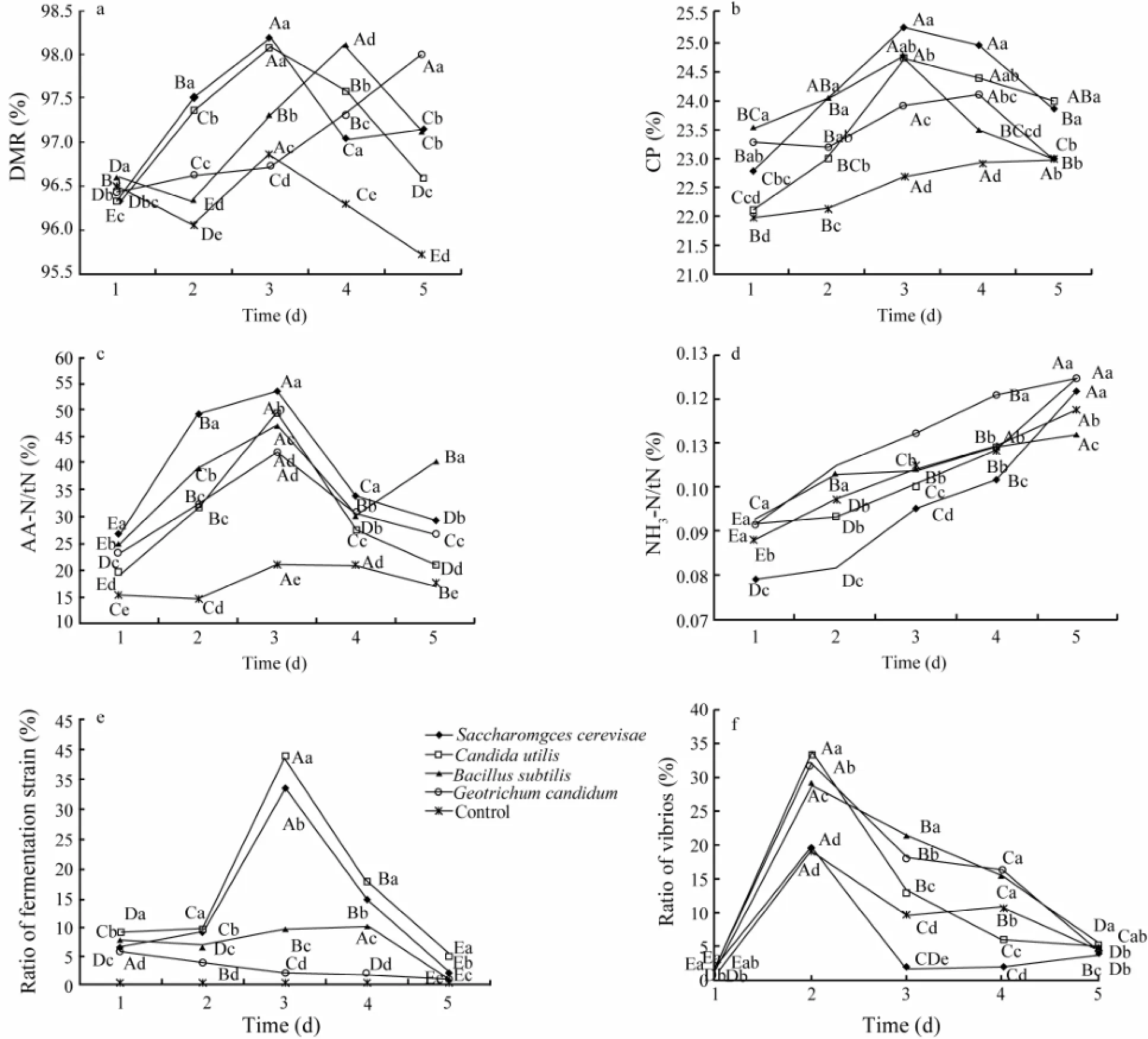
Fig.1 The changes of physicochemical indexes in five fermentation groups. Values denoted with different uppercase are significantly different at different time in the same fermentation strain (n = 3; P < 0.05); while those denoted with different lowercase are significantly different at the same time in different fermentation strain (n = 3; P < 0.05).
The effects of fermentation strains and fermentation time on AA-N/tN were, respectively, significantly different (P < 0.05). S. cerevisiae group, C. utilis group andG. candidum group had a similar trend in AA-N/tN (Fig.1c). The highest level (53.84%) appeared on the third day in S. cerevisiae group. There were significant differences among S. cerevisiae group and other four groups on the third day (P < 0.05), and the highest value of AA-N/tN was also significantly different from other days within S. cerevisiae group (P < 0.05). There were significant differences on AA-N/tN by the interactions of fermentation strains and fermentation time (P < 0.05).
The amino acid composition of the fermented feed was represented in Table 2 and Table 3. The total amount of amino acids increased at the beginning and then decreased during the fermentation process in S. cerevisiae group, G. candidum group and the control group, and the highest level was on day 3 in S. cerevisiae group. In fermentation, The ASP, GLU, HIS are the main amino acids in these fermentation feed. The changes of ASP in all treatments were irregular. The trend of GLU was a first increase and then decrease except Candida utilis, and the highest values (1.24%) appeared on the third day in S. cerevisiae group. The trend of HIS was a first increase and later decrease and the highest values (1.90%) appeared on the third day in S. cerevisiae group. Meanwhile, other low- content amino acids were also reached the highest level, i.e., GLY, SER, ALA and so on.
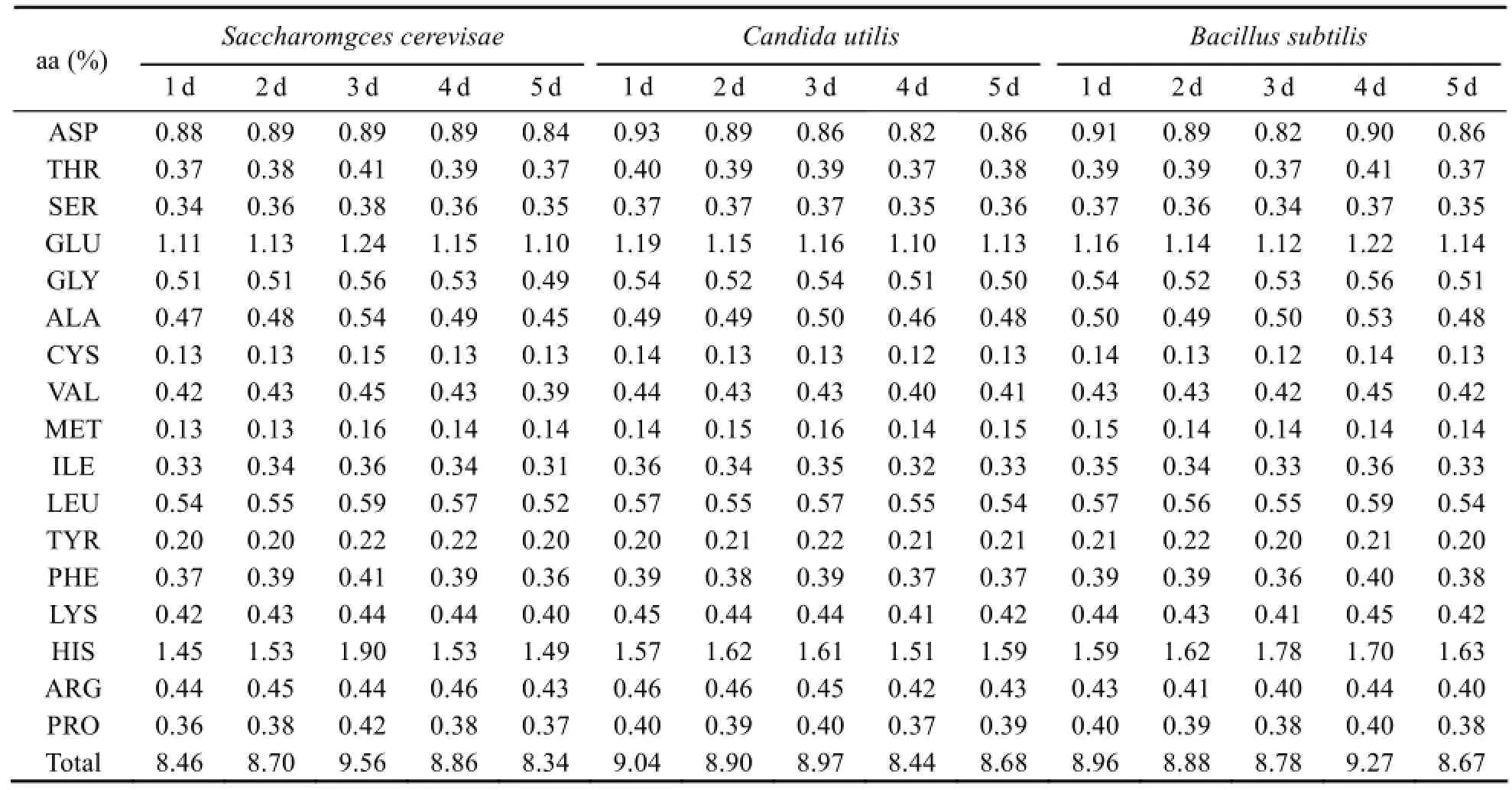
Table 2 The amino acid composition of the feed independently fermented by Saccharomgces cerevisae, Candida utilis and Bacillus subtilis in 5 days on a dry matter basis
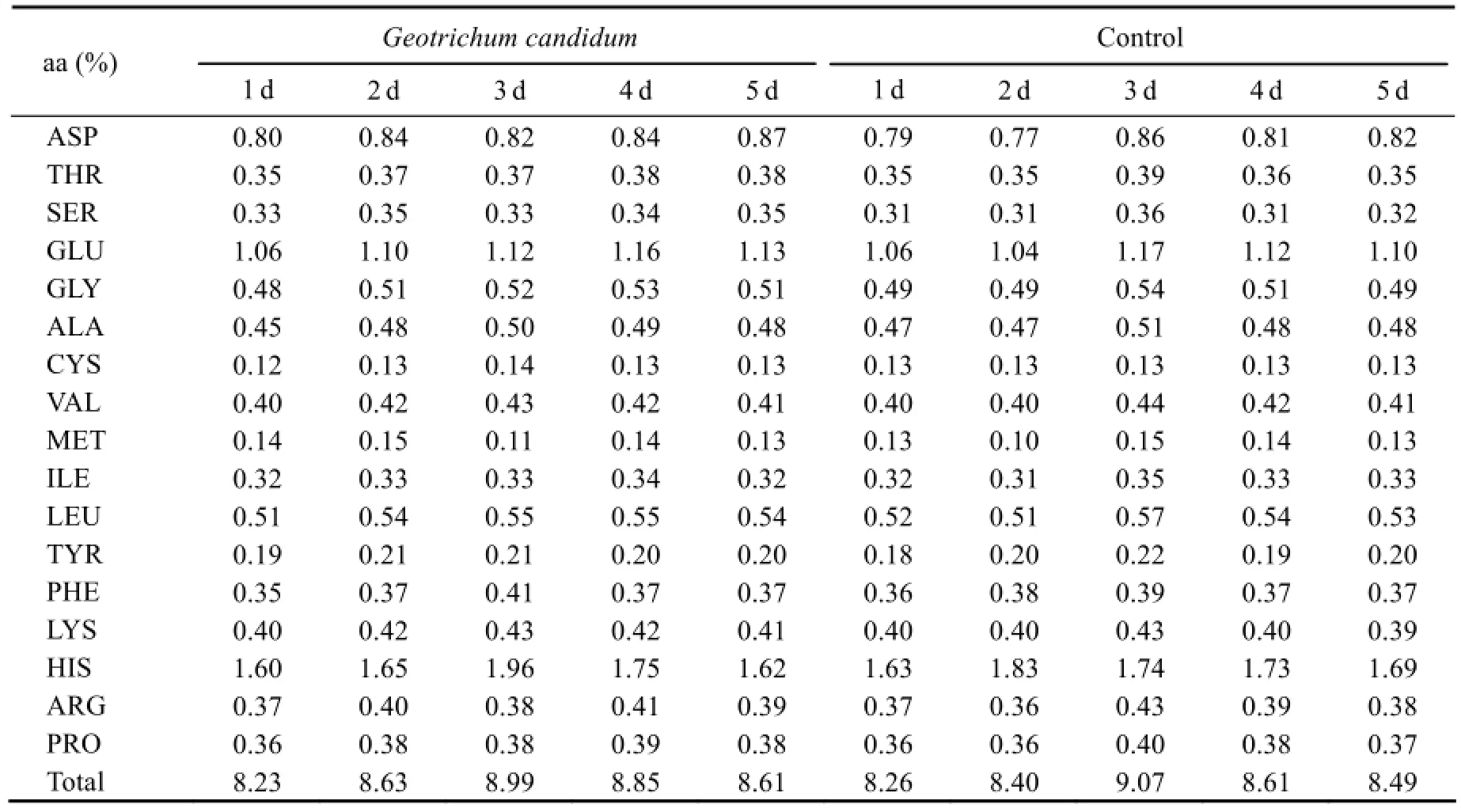
Table 3 The amino acid composition of the feed independently fermented by Geotrichum candidum and the control in 5 days on a dry matter basis
3.1.4 NH3-N/tN
Both of the fermentation strains and fermentation time affected NH3-N/tN values significantly (P < 0.05). The NH3-N/tN values in all five groups increased along with the time, the lower values appeared in the first day in each fermentation strain and the lowest (0.079%) was in S. cerevisiae group (Fig.1d). It was significantly lower than other four groups on the first day (P < 0.05) and there was no significant difference between the first and the second day (0.082%) within S. cerevisiae group (P >0.05). The interactions of fermentation strains and fermentation time were significantly different (P < 0.05).
3.1.5 The ratio of the fermentation strains to total microbes
There were significant differences on the ratio of the fermentation strains to total microbes by fermentation strains and fermentation time (P < 0.05), respectively. The same trend was observed in S. cerevisiae group and C. utilis group about the ratio of fermentation strain to total microbes (Fig.1e). The highest value was observed in C. utilis group, the third day, significantly higher than the remaining four groups at this time (P < 0.05) and each day within C. utilis group (P < 0.05). The interactions of fermentation strains and fermentation time were significantly different (P < 0.05).
3.1.6 The ratio of vibrios to total microbes
Fermentation strains and time affected the ratio of vibrios to total microbes significantly (P < 0.05). The ratio of vibrios to total microbes had the same trend in all five groups (Fig.1f). The lowest value was in S. cerevisiae group on the third day. It was significantly different from the rest of fermentation strains on the same day (P < 0.05) and there was no significant difference among the first day, third day and the fourth day within S. cerevisiae group (P < 0.05). There were significant differences on the ratio of vibrios to total microbes by the interactions of fermentation strains and fermentation time (P < 0.05).
3.2 Sensorial Evaluation
The sensorial changes of fermentation feed were shown in Table 4. In each fermentation group, the sensory evaluation scores increased at the beginning and then decreased during the fermentation. In each day, the sensory evaluation scores of the samples fermented by different strains were different. Generally, scores in day 3 were higher than those in other days. The highest score was observed in S. cerevisiae group on day 3. There were no significant differences between day 3 and day 4 in S. cerevisiae group (P > 0.05), and the highest scorewas not significantly different with C. utilis on day 3 (P> 0.05).
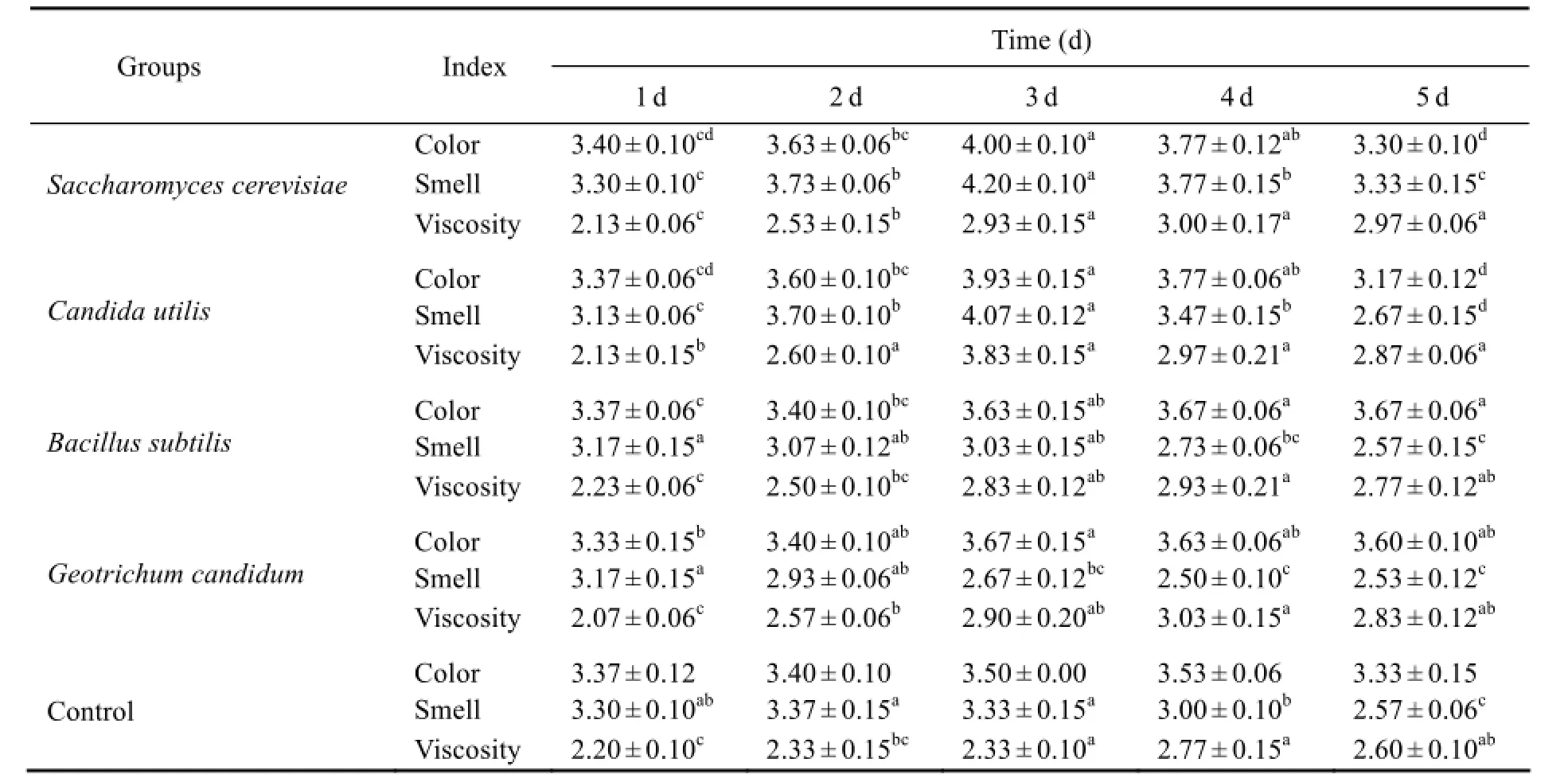
Table 4 Sensory evaluation of fermentation feed by different strains
4 Discussion
4.1 DMR, CP and AA-N/tN
Some raw materials would be consumed and some gases would be generated along with the growth of microbes. Thus the dry matter of fermentation feed would be reduced generally (Zhang and Chu, 1996). In this study, the similar results have been observed that all of the DMR values were below 100%. In addition, the fermentation container was semi-closed, and part of water would be evaporated, which may be the reason that the DMR was lower on day 1 and higher at the later time. With the longer period of fermentation, the feed started to decay, which lead to the dry matter reduction. The loss of DMR depends on fermentation process and timing. In this study, the highest DMR (98.19%) appeared on day 3 in S. cerevisiae group. This result was differentfrom previous researches (Zhang et al., 2007; Lv et al., 2011; Liu et al., 2011). The difference may be associated with the structure of the container, as closed fermentation containers were used in other studies.
CP content of yeast cells is high, accounting for about 50% of the dry matter. Therefore, some yeast cells, such as S. cerevisiae and C. utilis, were used directly as dietary protein or were used to produce dietary protein (Lu et al., 2007; Liu et al., 2009; Wang et al., 2011). In the process of growth and metabolism, some strains could degrade macromolecular organic matter into micromolecules and generate some useful metabolites, such as peptides, amino acids, and vitamins, and so on (Chen, 2005; Zhou et al., 2007; Jia et al., 2009). In this study, the content of some amino acids, such as GLY, SER, GLU and HIS, changed at different fermentation time, and the highest level was observed on day 3 in S. cerevisiae group. Meanwhile, the total amount of amino acids was also the highest. A study showed that CP content of soybean meal could improve 12.1% through fermentation by yeast and Aspergillus oryzae at 28℃ for 72 h (Mo and Huang, 2007). In addition, yeast could produce 1 mg mL-1alanine through fermentation at 28℃ for 72 h (Wang et al., 1992). In this study, the results showed that CP (25.24%) and AA-N/tN (53.84%) were the highest on day 3 in S. cerevisiae group. Meanwhile, S. cerevisiae was the dominate microbe and its abundance among microbes was higher than that observed on other days. This result illustrated that fermentation strain had stronger growth and metabolism on day 3 than on other days.
4.2 Microbes and NH3-N/tN
Franklin (1993) reported that the number of E. coli in calf feces could be significantly reduced when the diet containing yeast cell walls. Yeast could grow and reproduce in both aerobic and anaerobic environments (Andlid et al., 1995; Chi and Gao, 1999). The production efficiency of yeast in aerobic environment was ten times higher than that in anaerobic environment. Therefore, fermentation was commonly conducted in ventilation conditions (Wang and Lin, 1998). The pH value decreased in the later fermentation period, which indicated that the cells began to degrade and the growth of yeast has entered the decline phase. In this situation, the fermentation process should be ended (Wang and Lin, 1998).
The growth of S. cerevisiae was fast in early fermentation days. The ratio of the strain among the total microbes was 33.62% on day 3 and was higher than B. subtilis group, G. candidum group and control group. Additionally, the ratio of vibiros was only 1.82% on day 3 and lower than other four groups. This showed that the metabolites and nutrient competition could efficiently inhabit the growth and reproduction of vibiros.
With elongation of fermentation time, the ammonia nitrogen content in all experiment groups presented an increasing trend (Lv et al., 2011; Omafuvbe, 2002). As the fermentation time extended the growth of fermentation strains entered the decay period and went to decline gradually, and the harmful microbes grew more strongly (Wang and Lin, 1998). In this study, an increasing trend of NH3-N/tN was found during the fermentation process in S. cerevisiae group. The NH3-N/tN content was lower than other groups except on day 5, and the lowest content was 0.079% on day 1.
4.3 Sensorial Characteristics
The aromatic substances produced in fermentation by yeasts can improve both feed palatability and feed intake (Yun et al., 2010). The acid aroma appeared in S. cerevisiae group and C. utilis group, but lasted longer in S. cerevisiae group. The highest sensory evaluation score appeared in S. cerevisiae group on day 3, when color was grayish brown (close to sea mud), the viscosity was in ideal range, and the acid aroma was stronger than at other days. In addition, the ratios of fermentation strains were higher in S. cerevisiae and C. utilis group, which may be the reason that the sensorial characteristics were better on day 3.
5 Conclusions
In comparison, the physicochemical indexes DMR, CP and AA-N/tN reached the highest level in S. cerevisae group on day 3, where NH3-N/tN was maintained at a low level. Meanwhile, the ratio of fermentation strain to total microbes in S. cerevisae group was higher than those in B. subtilis group and G. candidum group, but the ratio of vibrios was lower than other four groups. At the same time, sensorial characteristics of S. cerevisae group including smell and color achieved its best condition. Thus S. cerevisae could be applied for feed fermentation for sea cucumber. The optimal condition is to ferment at 25℃ for 3 days with 70% water in the culture medium.
Acknowledgements
This study was financially supported by the National High Technology Research and Development Program, China (2012AA10A412), the National Natural Science Foundation of China (No. 31202016), the National Key Technology R&D Program (2012BAD17B03), Agriculture Seed Improvement Project of Shandong Province, Special Funds for Technology R&D Program in Research Institutes (2011EG134219), and Strategic Emerging Industry Cultivation Project of Qingdao (13-4-1-65-hy).
Andlid, T., Jufirez, R. V., and Gustafsson, L., 1995. Yeast colonizing the intestine of rainbow trout (Salmo gairdneri) and turbot (Scophtalmus maximus). Microbial Ecology, 30: 321-334.
Battaglene, S. C., Seymour, E. J., and Ramofafia, C., 1999.Survival and growth of cultured juvenile sea cucumbers Holothuria scabra. Aquaculture, 178: 293-322.
Brooks, P. H., 2003. Liquid feeding as a means to promote pig health. In: London Swine Conference–Maintaining Your Competitive Edge 9-10 April 2003. London, Ontario, 83-103.
Chen, X., 2005. Study on the improvement of soybean meal ferment Process technology and development of function of fermented soybean meal. PhD thesis. Huazhong Agricultural University, Wuhan, 1-51 (in Chinese with English abstract). Chi, Z. M., and Gao, J., 1999. The research progress of alcohol resistance mechanism of yeast. Microbiology China, 26 (5): 373-376 (in Chinese with English abstract).
Choe, S., 1963. Study of Sea Cucumber: Morphology, Ecology and Propagation of Sea Cucumber. Kaibundo Publishing House, Tokyo, 219pp.
Conand, C., 2004. Present status of world sea cucumber resources and utilization: An international overview. In: Advances in Sea Cucumber Aquaculture and Management. FAO, Rome, 13-23.
Demecková, V., Kelly, D., Coutts, A. G. P., Brooks, P. H., and Campbell, A., 2002. The effect of fermented liquid feeding on the fecal microbiology and colostrum quality of farrowing sows. International Food Microbiology, 79 (1-2): 85-97. Franklin, S. T., Newman, M. C., Newman, K. E., and Meek, K. I., 1993. Immune parameters of dry cows fed mannan oligosaccharide and subsequent transfer of immunity to calves. Journal of Dairy Science, 88 (2): 766-775.
Guo, C. H., Wei, R. L., Tao, W. Q., Chen, Z. H., and Tao, Z., 2009. Application of the protein feed processed by microbial fermentation to dairy cow. Journal of Southwest University for Nationalities Natural Science Edition, 35 (4): 759-763 (in Chinese with English abstract).
Hamel, J. F., Conand, C., Pawson, D. L., and Mercier, A., 2001. The sea cucumber Holothuria scabra (Holothuroidea, Echinodermata): Its biology and exploitation as Beche-de-Mer. Advances in Marine Biology, 41: 131-202.
ICS 07.060 A45, 2007. The Specification for Marine Monitoring-Part 4: Seawater Analysis. Standards Press of China, Beijing, 111-113.
Ikenebomeh, M. J., 1989. The influence of salt and temperature on the natural fermentation of African locust bean. International Journal of Food Microbiology, 8: 133-139.
Jensen, B. B., and Mikkelsen, L. L., 1998. Feeding liquid diets to pigs. In: Recent Advances in Animal Nutrition. Nottingham University Press, Nottingham, 107-126.
Jia, X. F., Li, A. K., Yao, J. H., Zhang, X. L., Zhou, N. J., Hao, S. H., and Pan, L., 2009. Effect of solid-state fermentation on gossypol detoxification and protein degradation in cottonseed meal. Journal of Northwest A&F University, 37 (3): 49-54 (in Chinese with English abstract).
Jiang, Y., Wang, Y. G., Xue, T. S., Zou, A. G., Liao, M. J., Zhang, Z., Zhu, J. X., Chen, G. P., Mai, K. S., and Zhang, W. B., 2012. The production and feeding experiment of fermented feed in pond cultuer system of sea cucumber, Apostichopus japonicus. Progress in Fishery Sciences, 33 (1): 66-71 (in Chinese with English abstract).
Kim, J. H., Heo, K. N., Odle, J., Han, K., and Harrell, R. J., 2001. Liquid diets accelerate the growth of early-weaned pigs and the effects are maintained to market weight. Journal of Animal Science, 79 (2): 427-434.
Kobashi, Y., Ohmori, H., Tajima, K., Kawashima, T., and Uchiyama, H., 2008. Reduction of chlortetracycline-resistant Escherichia coli in weaned piglets fed fermented liquid feed. Anaerobe, 14 (4): 201-204.
Li, W. J., Ni, Y. Z., Huang, H. K., Wang, X. M., Zhang, B. Z., and Niu, X. S., 2003. A preliminary studies of micro-ecological agents on ecological livestock husbandry. Journal of China Agricultural University, 8 (Supp.): 85-92 (in Chinese with English abstract).
Liu, J., Zhang, H., Wang, L., and Guo, X. N., 2010. Screening of producing high protein feedstuff strains by solid state fermentation of peanut meal. China Oils and Fats, 35 (6): 16-18 (in Chinese with English abstract).
Liu, T. X., Liu, Y. Q., and Ma, J. L., 2009. Study on fermentation of corn straw powder with multi-strains in feed production of proteins. Animal Husbandry and Feed Science, 30 (9): 36-38 (in Chinese with English abstract).
Liu, Y., Chen, X., Li, Z., Han, M. M., Xu, Q. F., Han, J. G., Yu, Z., and Bai, C. S., 2011. Effects of moisture content and additives on the quality of Agropyron elongatum silage. Acta Prataculture Sinica, 20 (6): 203-207 (in Chinese with English abstract).
Liu, Y., Dong, S. L., Tian, X. L., Wang, F., and Gao, Q. F., 2010. The effect of different macroalgae on the growth of sea cucumbers (Apostichopus japonicus Selenka). Aquaculture Research, 41: e881-e885.
Lu, B. S., Li, X. S., Wang, F. Y., and Li, L. L., 2007. Production of feed protein by Candida mycoderma on Daqu waste lees. China Brewing, 4 (169): 35-37 (in Chinese with English abstract).
Luo, Y. Q., Zhang, H., Xu, Y., Huang, Z. B., and Chu, J. S., 2011. Improvement of fiber palatability of bean curd residue mixed with apple marc by solid state fermentation. Transactions of the CSAE, 27 (Supp.1): 407-412 (in Chinese with English abstract).
Luo, Z., Liu, Y. J., Mai, K. S., Tian, L. X., Liu, D. H., and Tan, X. Y., 2004. Partial replacement of fish meal by soybean protein in diets for grouper Epinephelus coioides juveniles. Journal of Fisheries of China, 28 (2): 175-181.
Lv, W. L., Diao, Q. Y., and Yan, G. L., 2011. Effect of Lactobacillus buchneri on the quality and aerobic stability of green corn-stalk silages. Acta Prataculture Sinica, 20 (3): 143-148 (in Chinese with English abstract).
Mo, C. W., and Huang, G., 2007. Production of fermented soybean meal by solid state fermentation. China Oils and Fats, 32 (7): 38-40 (in Chinese with English abstract).
MOAC (Ministry of Agriculture, China), 2012. China Fisheries Yearbook. China agriculture Publisher, Bejing, 29-56.
Moriarty, D. J. W., 1982. Feeding of Holothuria atra and Sticopus chloronotus on bacteria, organic carbon and organic nitrogen in sediments of the Great Barrier Reef. Australian Journal of Marine & Freshwater Research, 33 (2): 255-263.
Okorie, O. E., Ko, S. H., Go, S., Lee, S., Bea, J. Y., Han, K., and Bal, S. C., 2008. Preliminary study of the optimum dietary ascorbic acid level in sea cucumber, Apostichopus japonicas (Selenka). Journal of the World Aquaculture Society, 39: 758-765.
?ner, M. D., Tekin, A. R., and Erdem, T., 1993. The use of soybean in the traditional fermented food–Tarhana. Food Science and Technology (Lebensmittel-Wissenschaft und-Technologie), 26 (4): 371-372.
Omafuvbe, B. O., Abiose, S. H., and Shonukan, O. O., 2002. Fermentation of soybean (Glycine max) for soy-daddawa production by starter cultures of Bacillus. Food Microbiology, 19: 561-566.
Seo, J. Y., Shin, I. S., and Lee, S. M., 2011. Effect of dietary inclusion of various plant ingredients as an alternative for Sargassum thunbergii on growth and body composition ofjuvenile sea cucumber Aspostichopus japonicus. Aquaculture Nutrition, 17 (5): 549-556, DOI: 10.1111/j.1365-2095. 2010.00849.x.
Sun, H. L., Liang, M. Q., Yan, J. P., and Chen, B. J., 2004. Nutrient requirements and growth of the sea cucumber, Apostichopus japonicus. In: Advances in Sea Cucumber Aquaculture and Management. FAO, Rome, 327-331.
Tamang, J. P., and Nikkuni, S., 1996. Selection of starter cultures for the production of kinema a fermented soybean food of the Himalaya. World Journal of Microbiology and Biotechnology, 12: 629-635.
Uthicke, S., 2004. Overfishing of holothurians: Lessons from the Great Barrier Reef. In: Advances in Sea Cucumber Aquaculture and Management. FAO, Rome, 163-171.
Wang, C. S., and Lin, J. Y., 1998. A nutritional fermented feed by using waste yeast from beer brewery. Journal of Oceanography in Taiwan Strait, 17 (supp.): 79-83 (in Chinese with English abstract).
Wang, P. Y., Wang, H. Y., Duan, W. J., Lu, X. F., and Cui, S. N., 2011. The study and application of Saccharomyces cerevisiae source feed additives. Feed Industry Magazine, 32 (2): 30-35.
Wang, X. X., Yi, Z. H., Ji, C., Ma, Q. G., and Chen, X. D., 2006. Effects of fructo-oligosaccharide and Bacillus subtilis on intestinal microflora, fecal emission of ammonia and sulfureted hydrogen and nutrient availability in broilers. Acta Veterinaria et Zootechnica Sinica, 37 (4): 337-341 (in Chinese with English abstract).
Wang, Y. G., Fang, B., Zhang, C. Y., and Rong, X. J., 2006. Etiology of skin ulcer syndrome in cultured juveniles of Apostichopus japonicus and analysis of reservoir of the pathogens. Journal of Fishery Sciences of China, 13 (4): 610-616 (in Chinese with English abstract).
Wang, Y. G., Rong, X. J., Zhang, C. Y., and Sun, S. F., 2005. Main diseases of cultured Apostichopus japonicus: Prevention and treatment. Marine Sciences, 29 (3): 1-7 (in Chinese with English abstract).
Yang, N., Wang, W., Lin, S. C., Chen, X. P., and Zhang, W. J., 1992. The research of amino acid fermentation by yeast. Amino Acid Magazine, 4:10-16.
Yang, X., Xue, Y. L., and Li, L., 2011. Improvement of nutritional value of bran fermented by multi-strains in solid-state fermentation. China Brewing, 3: 113-115 (in Chinese with English abstract).
Yingst, J. Y., 1976. The utilization of organic matter in shallow marine sediments by an epibenthic deposit-feeding holothurian. Journal of Experimental Marine Biology and Ecology, 23 (1): 55-69.
Yuan, C. Y., 2005. Current status and development of feed in sea cucumber. Fisheries Science, 24 (12): 54-56 (in Chinese with English abstract).
Yuan, X. T., Yang, H. S., Zhou, Y., Mao, Y., Zhang, T., and Liu, Y., 2006. The influence of diets containing dried bivalve feces and/or powdered algae on growth and energy distribution in sea cucumber Apostichopus japonicus (Selenka) (Echinodermata: Holothuroidea). Aquaculture, 256: 457-467. Yun, J. M., Liu, L. S., An, Z. G., Su, Y. S., and Guo, B., 2010. Technology of single cell protein feed production from raw potato starch residue by multi-strains solid fermentation. Transactions of the CSAE, 26 (Supp.2): 399-404 (in Chinese with English abstract).
Zhang, B. L., Sun, D. Y., and Wu, Y. Q., 1995. Preliminary analysis on the feeding habit of Apostichopus japonicus in the rocky coast waters off Lingshan Island. Marine Sciences, 3: 11-13 (in Chinese with English abstract).
Zhang, H., and Chu, X. N., 1996. The study of transformation ability of nonprotein nitrogen by solid fermented forage yeast. Feed Industry Magazine, 17 (2): 17-19 (in Chinese with English abstract).
Zhang, J., Feng, X. Y., Liu, X. B., Xie, G., Fang, Q., and Luo, H., 2011. Process optimization of brewers’ grains fermentation using photosynthetic bacteria to make fish feed. Transactions of the CSAE, 27 (8): 387-392 (in Chinese with English abstract).
Zhang, S. Z., Zhou, Z. M., and Meng, Q. X., 2007. Effects of different biology additives on the fermentation quality and digestibility of whole corn silage in vitro. Chinese Journal of Animal Science, 43 (1): 53-56 (in Chinese with English abstract).
Zhou, F. Z., Xie, B. E., Jia, Y. L., and Wang, H. Y., 2007. Analysis of ferment bean meal using probiotics and its produce. Feed Industry, 28 (6): 35-37 (in Chinese with English abstract).
Zhu, J., Liu, H., Leng, K., Wang, S., Xue, Z., and Sun, Y., 2007. Studies on the effects of some common diets on the growth of Apostichopus japonicus. Marine Fisheries Research, 25: 48-53 (in Chinese with English abstract).
Zhuang, Y. F, Zhang, W. C., Chen, X. Z., Luo, T. Y., and Lin, B. F., 2006. Effect on the quality of fermented fungus chaff feed supplied by green ferment juice and cellulose. Journal of Inner Mongolia University for Nationalities, 21 (6): 653-655 (in Chinese with English abstract).
(Edited by Qiu Yantao)
(Received January 21, 2014; revised April 24, 2014; accepted May 27, 2015)
J. Ocean Univ. China (Oceanic and Coastal Sea Research)
DOI 10.1007/s11802-015-2591-3
ISSN 1672-5182, 2015 14 (5): 873-880
http://www.ouc.edu.cn/xbywb/
E-mail:xbywb@ouc.edu.cn
* Corresponding author. Tel: 0086-532-85841732
E-mail: wangyg@ysfri.ac.cn
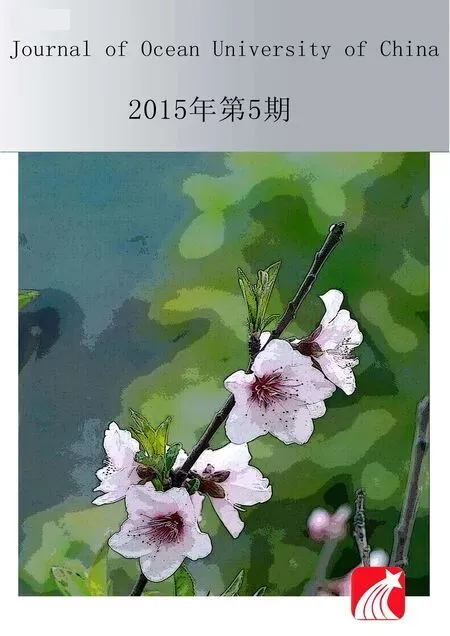 Journal of Ocean University of China2015年5期
Journal of Ocean University of China2015年5期
- Journal of Ocean University of China的其它文章
- The Mechanism of the Acclimation of Nannochloropsis oceanica to Freshwater Deduced from Its Transcriptome Profiles
- A Carboxymethyl Cellulase from a Marine Yeast (Aureobasidium pullulans 98): Its Purification, Characterization, Gene Cloning and Carboxymethyl Cellulose Digestion
- Effects of Dietary Stachyose on Growth Performance, Digestive Enzyme Activities and Intestinal Morphology of Juvenile Turbot (Scophthalmus maximus L)
- Pharmacokinetics and Biodegradation of Chitosan in Rats
- Pharmacokinetics and Biodegradation Performance of a Hydroxypropyl Chitosan Derivative
- Changes in Plasma Osmolality, Cortisol and Amino Acid Levels of Tongue Sole (Cynoglossus semilaevis) at Different Salinities
